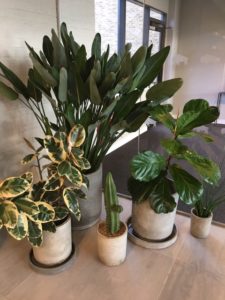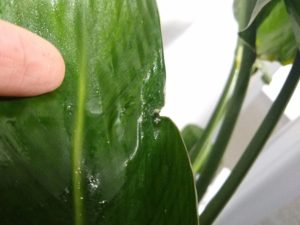The obsession for houseplants seems to be getting bigger and even more so this past year due to a national pandemic and never ending lock downs, people want to feel closer to nature when spending so much time in their homes.
According to the Barometer of Trade report published by the Garden Centre Association (GCA), sales of house plants were up by 81.82% in July 2020 compared to the same month in 2019.
It seems that we are becoming fond of tending to indoor plants and finding ourselves with an ever expanding collection in all corners of our homes, but do we really know what we’re doing?

You might think it easy to keep them alive with a regular watering each week, but Bedford Heights Head Gardener Dave Boyd tells us otherwise. Apparently there’s a little more to it than that, especially in the cooler months when there are other tips to consider.
Dave explains: “Plants need more care in the cooler months primarily because we’ve placed them in a human temperate environment that doesn’t follow the natural order. Our homes are hotter and drier with the central heating turned up and as plants haven’t naturally grown inside, they become more high maintenance without the helping hand of mother nature taking care of the watering, temperature moderation, air humidity, light and nutrients and so on.’’
Dave shares his top tips with us below, which will hopefully get you on the road to happier, healthier plants:
Watering Correctly
One main thing people tend to do at the beginning is over water, especially in the winter months. The growth rate of a plant slows down in the winter so it’s important to keep the soil drier and only water when the majority of the root ball has dried out.
It’s a good idea to get a watering probe to help you know when it’s time to water, but if you don’t have one then you can test with your finger. If the top inch or two is completely dry then it’s time to give it a water.
You’ll be able to tell if you’ve been overwatering if you see the newly grown leaf turning yellow as well as the old. This means you may well have a root rot problem that needs sorting.
Heat in the home
Interior plants can really suffer from the central heating being on, particularly in the winter months. Radiators or air conditioning vents can dry out the leaves very quickly if no consideration is taken towards the plant’s needs.
You can often see the plant’s leaf margins turning brown, however you can help avoid this by adding a saucer underneath the plant pot with water and pebbles in. This humidifies the water to the underside of the leaves, that in effect waters the plant’s leaves through their stomatas.
You should also place plants away from main doorways that allow cold draughts into the environment. In some cases, this can work better if the plant likes a cooler, more humid environment for the winter months such as an Aeonium and hardy cactuses which would do well in a cool conservatory environment. However, in most cases the draught will scorch the tender plant leaves or deform and make them smaller. Usually plants with big broad leaves such as an Alocasia, Philodendron and Swiss Cheese require more humidity and do better in a bathroom environment, whereas your classic succulent plant like a money plant is much more resilient in less humid conditions.
The important thing is to get to know where your plant comes from and the environmental conditions. If it grows in a desert environment, then it’s more likely to survive the perils of the dreaded radiator death and if it’s got big luscious leaves then it’s going to be fussier and will not want to be anywhere near a radiator or draughts.

Lighting conditions
One thing that any broad leaf plant needs, especially in the winter months, is to have its leaves clean of dust every one to two weeks to keep the plant’s engine of growth at its best for photosynthesis.Some plants, such as a ZZ plant (Zamioculcas Zamiifolia), are excellent interior plants because they are resilient. They are good on all levels and require little attention but most of all they can deal with full light as well as a dark corner in your house; dry, cold or humid.
It’s handy to have these plants so you can swap them around with other plants that need more light or need to escape a radiator in the winter. You should get to know your plants’ needs in terms of light and then prioritise where they need to be positioned in your home in the summer months compared to winter. North facing windows do well for shade loving plants and resilient plants such as a Cast Iron plant, the name gives it away don’t you think?
Plants that do well in indirect sunlight will do fine on east and west window sills, just don’t over water these three orientations as it has a shorter length of day which means the plant is not growing as much as a south facing window. South facing windows are certainly the mostly favourable for the majority of plants in the cooler months. They are key for plants such as cacti and succulents for the most part. I also use south facing windows as a nursery for other plants that need more light in the winter, to revive them by plant rotation.
Pests
Unfortunately, insects find a way into your home and they are pretty good at it as well. When you get pests in an isolated situation such as a home environment, populations of insects can get out of control due to a lack of other opportunities, so it’s important that you get on top of them before they take over the whole of your plant.
The most common pest are mealy bugs, scale, aphids and red spider mite. Mealy bugs are by far the most problematic in the cooler months of the year at Bedford Heights. All of these can be treated with an organic spray with the main ingredient being pyrethrum. You can also use 70% rubbing alcohol neat with cotton buds to clean large infestations.
Control of mealy bugs can mainly be managed by a good leaf cleaning schedule. Clean the plant leaves every one to two weeks with a leaf polish. Whilst doing this you can investigate the plant and decide if it is necessary to use an insecticide or using cleaning alcohol.

We hope this has helped, if you have any specific questions then please get in touch with us on social media as we’d be happy to help.
For general enquiries:
Tel 01234 244 500
Brickhill Drive
Bedford,
Bedfordshire
MK41 7PH
United Kingdom


